
In the following three articles, we will discuss the nervous, myofascial, and circulatory systems and how they can be driven to affect positive performance outcomes.
None of these systems exist in isolation, meaning the healthy function of all three systems is important to reach the desired outcome.
As we discuss these systems, the following analogy can provide helpful insight. The myofascial system is like the hardware, literally the meat of our bodies. The nervous system is like software; it is the most technical and easiest to misunderstand. The circulatory system is like the wires, cables, and cooling fans that support both systems. The circulatory system is vital for operation but tends to get overlooked.
Most of us get excited about the nervous system because it allows us to achieve top-end potential to extract maximal power from the hardware. In addition, the nervous system is important for governing our body so it can recover from stress and learn skills.
The nervous system comprises several parts. To simplify our discussion of the nervous system as it relates to training, we will focus primarily on the autonomic nervous system. The autonomic nervous system governs two tones: sympathetic and parasympathetic.
If you are reading this article, you’re probably good at activating your sympathetic nervous tone. When our bodies are ramped up in training, this is the tone we’re in.
Truth be told, a sympathetic state is easy to influence. We can make our environment more aggressive (turn the music up, offer a back slap, yell up). We can also influence it through programming by decreasing reps and sets, lifting closer to maximal intensity, or utilizing strategies like the future method or post-activation potentiation.
A sympathetic nervous tone and the ability to tap into it are massively important to training. However, I’m going to argue that most coaches and athletes spend too much time and attention here. When we are in this state, the hardware is working very hard and Is prone to overheating. If we always attempt to live here, the system will not be able to upgrade and will begin to malfunction.
A parasympathetic tone promotes restoration in our bodies so they can be prepared for future top-end efforts. When a parasympathetic tone is dominant, we are downregulated. Our heart rate slows, aiding repair, and our digestive tract begins to activate and do its job. In other words, our body diverts resources to healthy function rather than vigilance, survival, and maximum output.
If we do not take time to actively transition to a parasympathetic state, then our bodies continue to operate in high gear.
This is a much more expensive state to operate in.
I think of downregulating to a parasympathetic state as taking control of my nervous system. For me, it is the least enjoyable part of training. However, I have come to see it as essential.
My resting heart rate and sleep quality improve when I downregulate after a session or a stressful event. These metrics are important for me to track because when they improve, I know that my muscle synthesis and testosterone levels improve. This means I’m getting better faster and have more to give for my next training effort.
I can track these markers objectively to know I’m training intelligently. Subjectively, I also feel better and stronger when I put myself In a parasympathetic tone. Our Breath and Exposure program has an entire curriculum dedicated to this.
If you want to get the most out of your training, you’ve got to train all aspects of your nervous system, not just the fun parts.
8/8/24 WOD
DEUCE Athletics GPP
Complete 4 rounds of the following:
8 Anderson Front Squats
Complete 3 rounds for quality of:
10 DB Goblet Roller Reverse Lunges (ea)
50-Yard KB Front Rack Suitcase Offset Carry
EMOM 12
Min 1: 15 Inverted Rows
Min 2: 12 Lateral Medball Slams
Min 3: :30 Double Unders
DEUCE Garage GPP
10-10-10-10
Incline Bench press
Complete 3 rounds for quality of:
10 DB Push Presses
8 1/2 Kneeling KB Windmills – Left
8 1/2 Kneeling KB Windmills – Right
Then, AMRAP 9:
9 Knees-to-Elbows
18 KB Swings (70/53)




